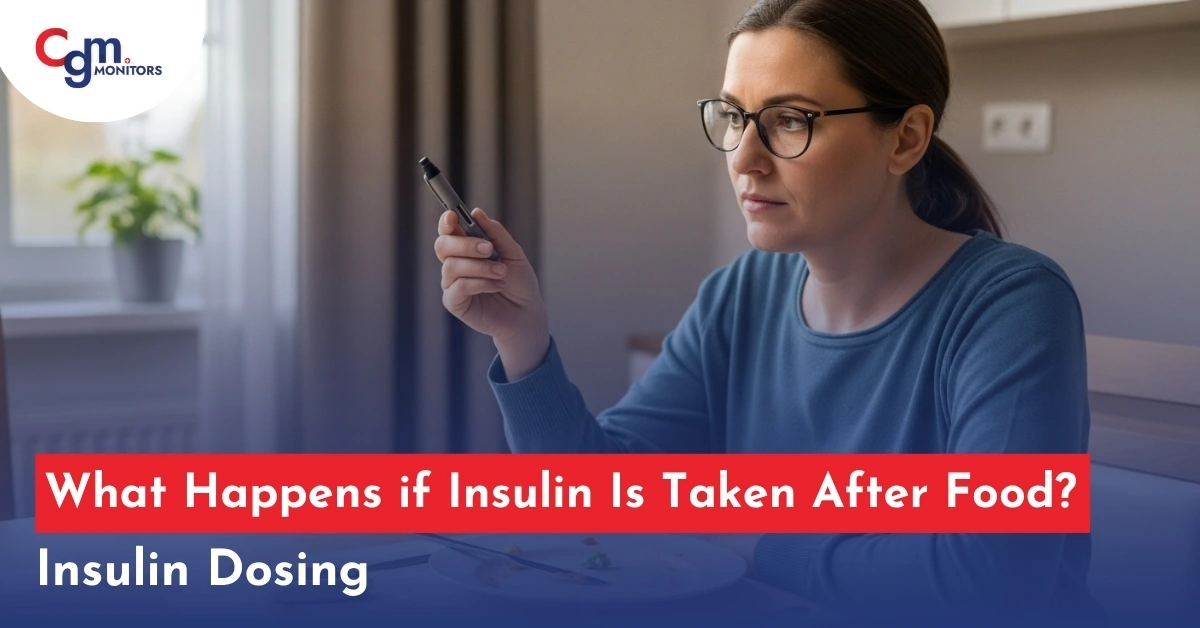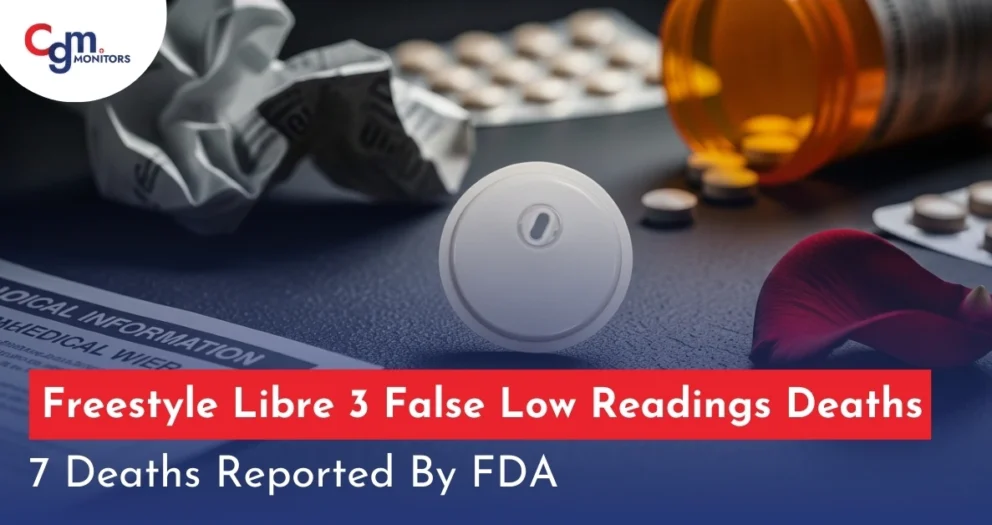Table of content
Monitoring glucose levels and managing insulin is critical for anyone living with diabetes. While this has been hectic for most diabetic individuals, the continuous glucose monitors (CGMs) have reduced the glucose monitoring worries, and automatic insulin delivery systems have removed the need for multiple injections throughout the day. There is a common question, ‘What happens if insulin is taken after food?’
Generally, injecting insulin after a meal, especially more than 15–30 minutes post-meal, can result in mismatched timing between glucose absorption and insulin action. Resulting in a blood sugar spike after the meal, followed by a potential late drop (hypoglycemia), creating what many patients describe as a “rollercoaster” effect. (Roalcoaster: refers to frequent and extreme fluctuations in blood sugar levels)
Can I Take Insulin 2 Hours After Eating?
Technically, yes, but it is not clinically recommended unless under guided correction dosing from your doctor. After 2 hours, the insulin will peak when blood glucose is already declining, increasing hypoglycemia risk.
A patient from Ohio who took rapid-acting insulin 45 minutes after a carbohydrate-heavy lunch (without consulting her CGM data or adjusting dose) experienced a delayed crash in blood sugar while driving home – an episode that could have been avoided with more precise timing.
Insulin Types, Timing & Table
As shared by the ADA, the following table specifies insulin types, their peak times, and preferred times of consumption:
| Insulin Type | Preferred Time | Peak Time | Duration | How to Consume |
| Rapid-acting (lispro/aspart/glulisine) | 10–15 min before meal (or right before first bite) | ~1 or 2 hours post-dose | ~2–4 hours | Subcutaneous injection in the abdomen; insulin after eating reduces efficacy and increases hypoglycemia risks. |
| Short-acting (Regular) | 30 minutes before a meal | 2–3 hours | ~3–6 hours | Inject 30 min before a meal; insulin after eating delays absorption. |
| Intermediate-acting (NPH) | Usually 1–2 times daily, at consistent times | 4–12 hours | ~12–18 hours | Inject subcutaneously (thigh/buttocks); avoid doing so right before intense exercise |
| Long‑acting (degludec /detemir/glargine) | Once or twice daily, same time | Minimal peak | Up to 24 hours | Inject into thigh/buttocks/arm, rotate the site |
| Ultra Long-Acting Insulin (glargine U-300) | Once or twice daily, same time | No peak times | Up to 36 hours | Tummy, buttocks, or thighs (sides). Change the site each time |
As Intermediate-Acting Insulin is consumed once or twice a day and not exactly, not exactly before meal times. This intermediate acting insulin keeps your blood sugar controlled throughout the day. However, you may need to take short-acting or fast-acting insulin along with it.
Factors: carbohydrate load, stress, activity, and injection site absorption. The time gap between insulin and food must be consistent; deviation leads to unpredictable glycemic response.
Rotate within zones (≥1 cm apart) to avoid lipohypertrophy; do not inject into muscle.
Can You Drink Insulin Instead of Injecting It?
Can you drink insulin instead injecting it? No—and this isn’t just theoretical. Insulin is a delicate protein hormone. When swallowed, it enters the digestive system, where stomach acids and enzymes break it down just like dietary proteins. This renders the insulin inactive before it even reaches your bloodstream.
This is why all FDA-approved insulin therapies in the U.S. are either:
- Injected subcutaneously, or
- Inhaled via the lungs (e.g., Afrezza, a rapid-acting insulin approved by the FDA for adults with diabetes).
A real-world example: a patient in California participating in a clinical trial for oral insulin needed over 10× the normal injected dose to get comparable effects—an approach deemed neither practical nor safe for general use. So, while oral insulin is being researched, it’s currently not a viable or approved option.
Did you know?
CGM sensors, such as Freestyle Libre 2 Plus Sensors, not only monitor your blood but are also compatible with automatic insulin delivery (AID) systems, such as Omnipod 5.
Insulin Injecting Sites

A common misconception is whether insulin injections can be administered into the muscle. No, it must be subcutaneous (under the skin), not intramuscular.
Injecting insulin into the muscle can:
- Cause too rapid absorption,
- Lead to unpredictable action,
- And increase the risk of severe hypoglycemia, especially during or after physical activity.
This is particularly relevant for active individuals. For example, a patient from Texas who unintentionally injected into the thigh muscle before a morning run experienced shaking and confusion halfway through her jog. Muscle tissue is highly vascular, meaning insulin enters the bloodstream too quickly from those sites.
Standard U.S. injection sites recommended by ADA include:
- Abdomen (fastest and most consistent absorption)
- Upper outer arm
- Front of the thigh
- Upper buttocks/lower back
Use a short needle (4mm or 6mm is standard in the U.S.) and gently pinch the skin to ensure it goes into the fat layer—not the muscle. Rotating injection sites is critical to avoid lipohypertrophy (fat buildup under the skin that alters absorption).
Timing, Meal Composition, and Practical Adjustments
Insulin after eating requires extra caution. Let’s say you forget your pre-meal bolus and eat a meal with high glycemic index (like white bread or mashed potatoes). Even injecting 20 minutes later won’t adequately “catch up” with the glucose spike, especially with short-acting insulin. In such cases, dose adjustments or mealtime planning using a bolus calculator (found in many smart insulin pens and pump apps) is essential.
Does injecting insulin frustrate you?
An automatic insulin delivery (AID) system can remove the need of injections and you may be eligible to claim one using insurance. Get a free eligibility check now with CGM Monitors.
U.S. diabetes care teams often recommend pre-bolusing 15–20 minutes before meals, unless you’re eating high-fat meals (e.g., burgers, pizza), which slow gastric emptying. Then, a dual-wave or extended bolus (for insulin pump users) may be more appropriate.
Conclusion
Managing insulin requires attention to timing, injection site, and meal composition. There are Rapid, Short, Intermediate, Long acting, and Ultra-long acting insulin types – depending on the insulin type you consume, you need to set the time of consuming it. Consuming insulin at wrong times increases the chances of adverse effects like hypoglycemia.
CGM sensors monitors your blood sugar without needing to prick fingers, the latest ones are even compatible with AID systems. On top of these devices can be managed with the help of a handheld controller and are fully smartphone-compatible (compatible devices) as well. Thus, allowing you to monitor blood sugar and consume insulin dosages with just a tap on your smartphone or handheld controller.
Disclaimer: This blog is only for informational purposes and does not substitute your doctor’s advice.







Write a comment
Your email address will not be published. All fields are required